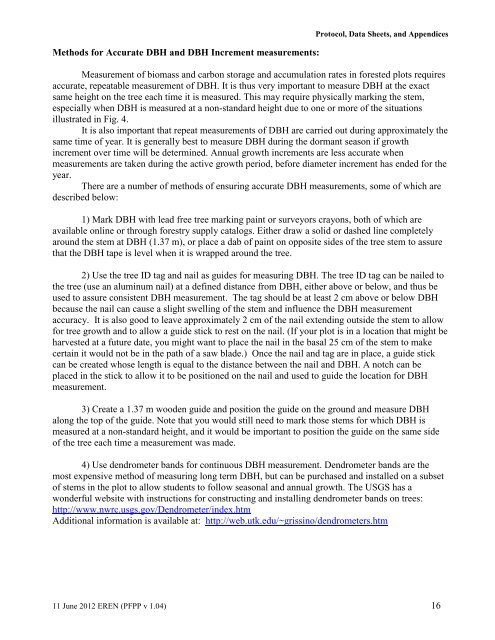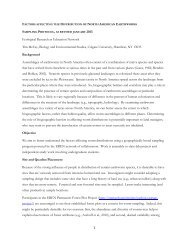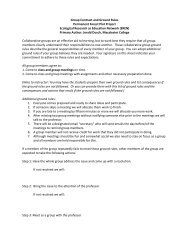Permanent Forest Plot Project (PFPP) - EREN
Permanent Forest Plot Project (PFPP) - EREN
Permanent Forest Plot Project (PFPP) - EREN
Create successful ePaper yourself
Turn your PDF publications into a flip-book with our unique Google optimized e-Paper software.
Methods for Accurate DBH and DBH Increment measurements:Protocol, Data Sheets, and AppendicesMeasurement of biomass and carbon storage and accumulation rates in forested plots requiresaccurate, repeatable measurement of DBH. It is thus very important to measure DBH at the exactsame height on the tree each time it is measured. This may require physically marking the stem,especially when DBH is measured at a non-standard height due to one or more of the situationsillustrated in Fig. 4.It is also important that repeat measurements of DBH are carried out during approximately thesame time of year. It is generally best to measure DBH during the dormant season if growthincrement over time will be determined. Annual growth increments are less accurate whenmeasurements are taken during the active growth period, before diameter increment has ended for theyear.There are a number of methods of ensuring accurate DBH measurements, some of which aredescribed below:1) Mark DBH with lead free tree marking paint or surveyors crayons, both of which areavailable online or through forestry supply catalogs. Either draw a solid or dashed line completelyaround the stem at DBH (1.37 m), or place a dab of paint on opposite sides of the tree stem to assurethat the DBH tape is level when it is wrapped around the tree.2) Use the tree ID tag and nail as guides for measuring DBH. The tree ID tag can be nailed tothe tree (use an aluminum nail) at a defined distance from DBH, either above or below, and thus beused to assure consistent DBH measurement. The tag should be at least 2 cm above or below DBHbecause the nail can cause a slight swelling of the stem and influence the DBH measurementaccuracy. It is also good to leave approximately 2 cm of the nail extending outside the stem to allowfor tree growth and to allow a guide stick to rest on the nail. (If your plot is in a location that might beharvested at a future date, you might want to place the nail in the basal 25 cm of the stem to makecertain it would not be in the path of a saw blade.) Once the nail and tag are in place, a guide stickcan be created whose length is equal to the distance between the nail and DBH. A notch can beplaced in the stick to allow it to be positioned on the nail and used to guide the location for DBHmeasurement.3) Create a 1.37 m wooden guide and position the guide on the ground and measure DBHalong the top of the guide. Note that you would still need to mark those stems for which DBH ismeasured at a non-standard height, and it would be important to position the guide on the same sideof the tree each time a measurement was made.4) Use dendrometer bands for continuous DBH measurement. Dendrometer bands are themost expensive method of measuring long term DBH, but can be purchased and installed on a subsetof stems in the plot to allow students to follow seasonal and annual growth. The USGS has awonderful website with instructions for constructing and installing dendrometer bands on trees:http://www.nwrc.usgs.gov/Dendrometer/index.htmAdditional information is available at: http://web.utk.edu/~grissino/dendrometers.htm11 June 2012 <strong>EREN</strong> (<strong>PFPP</strong> v 1.04) 16




